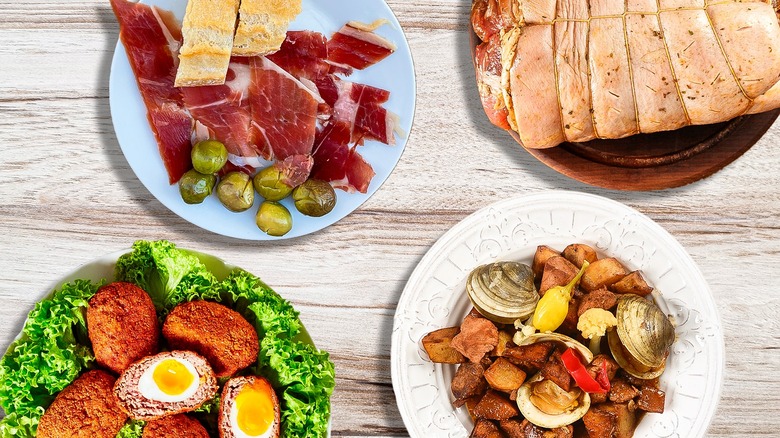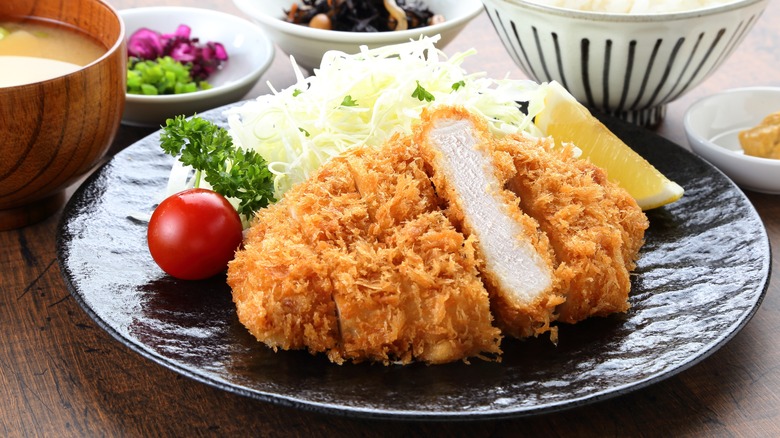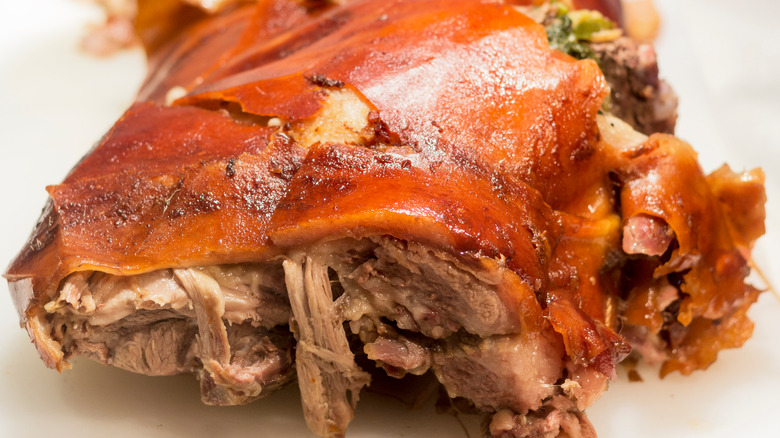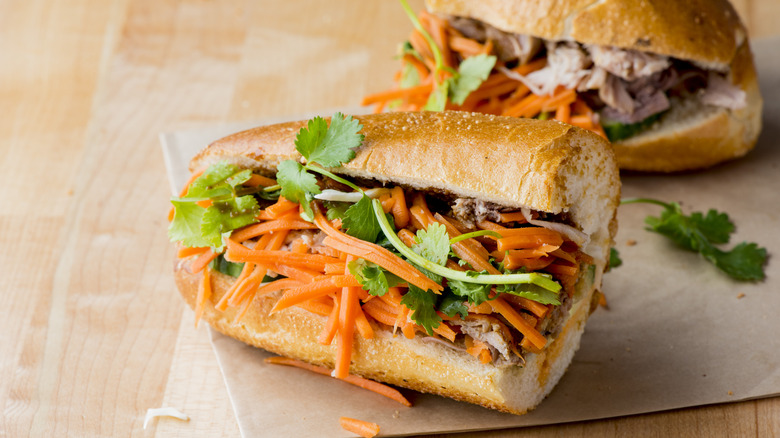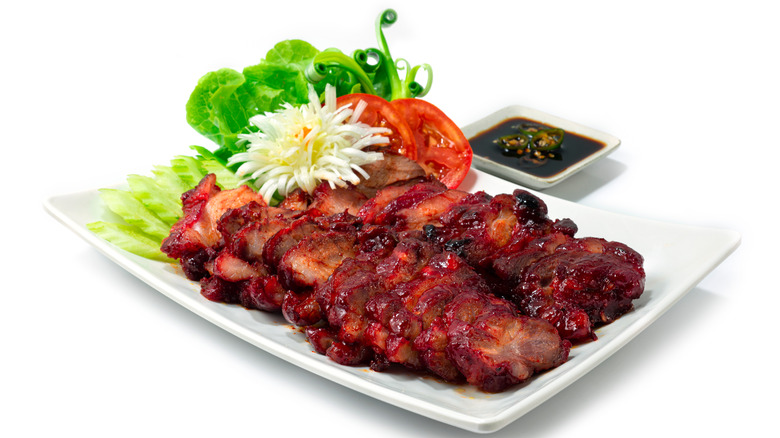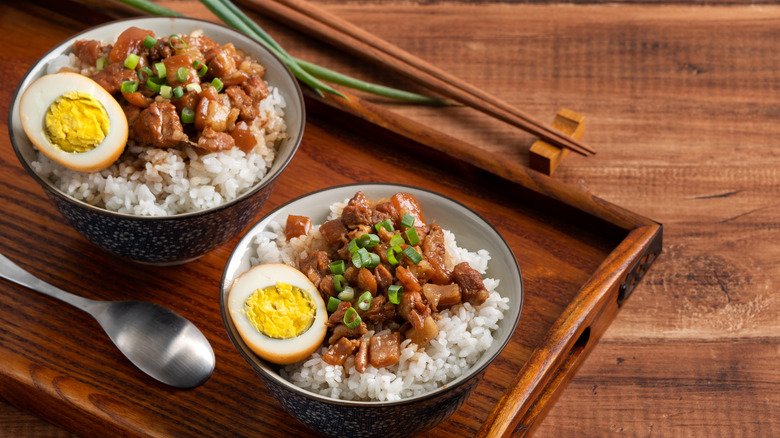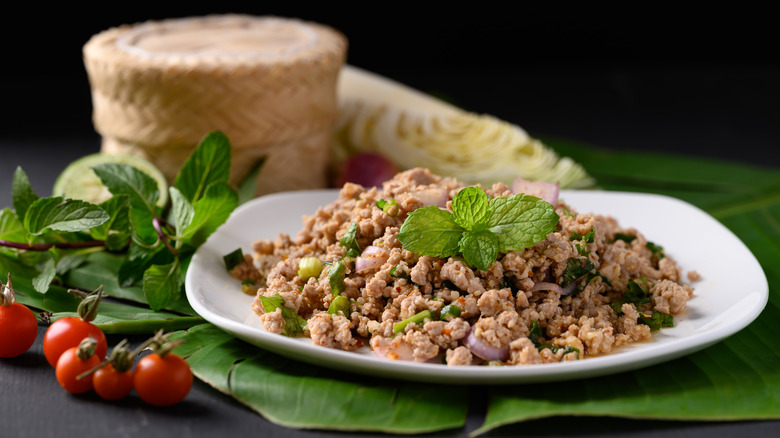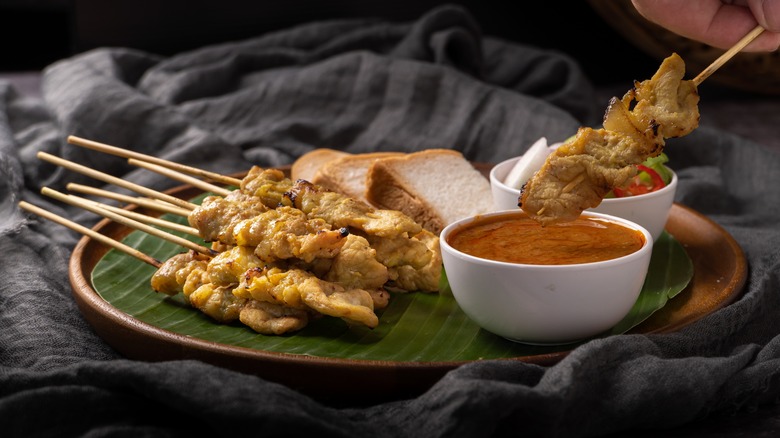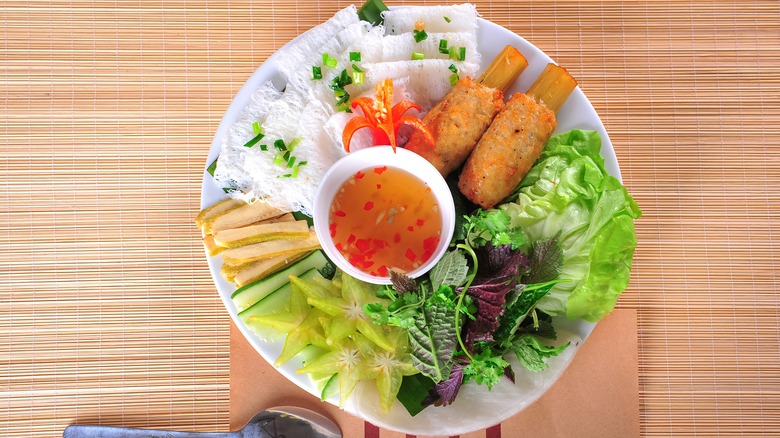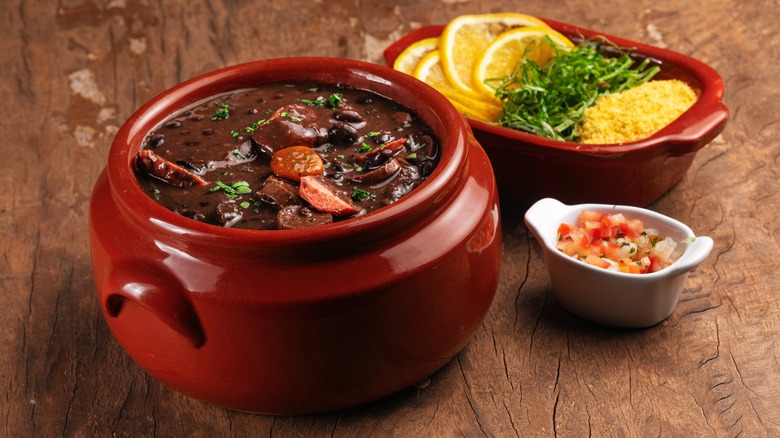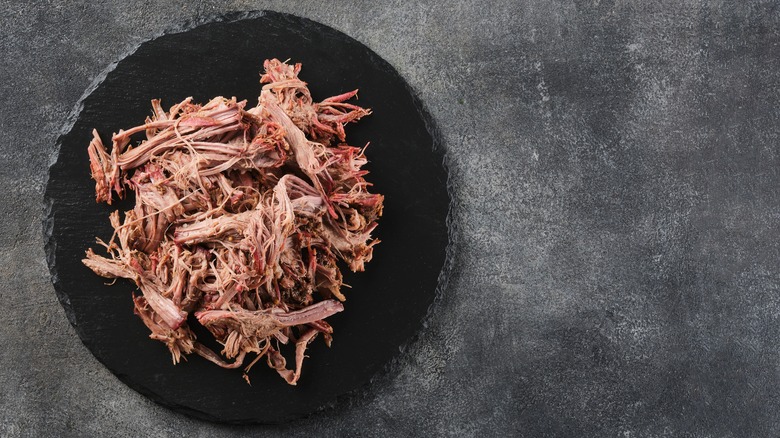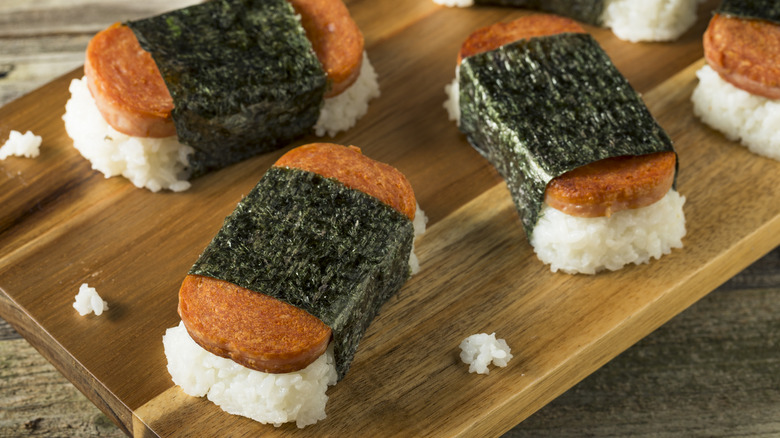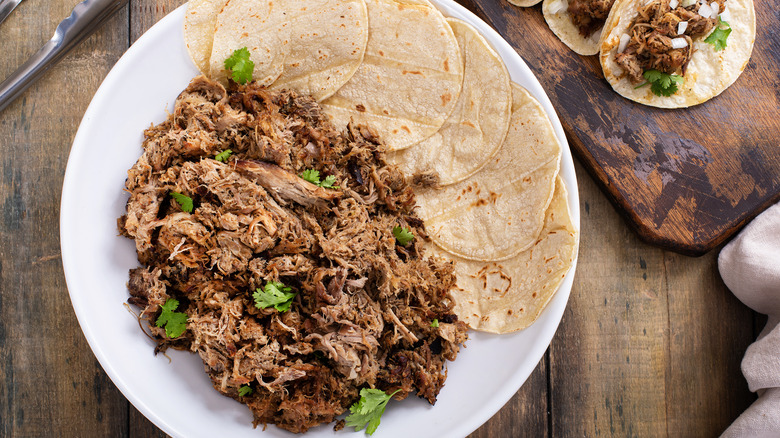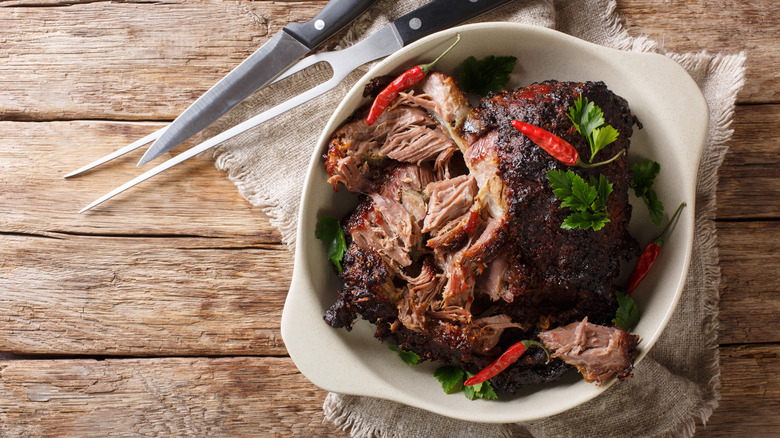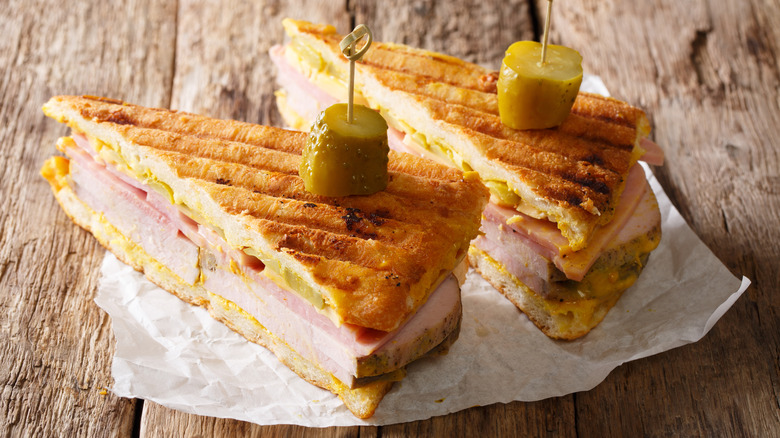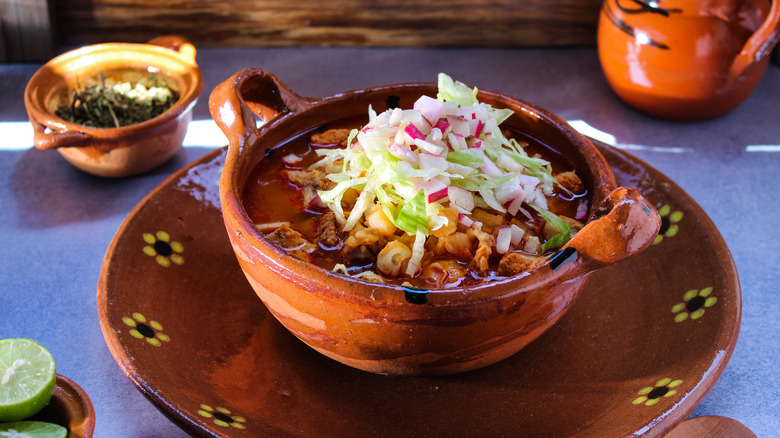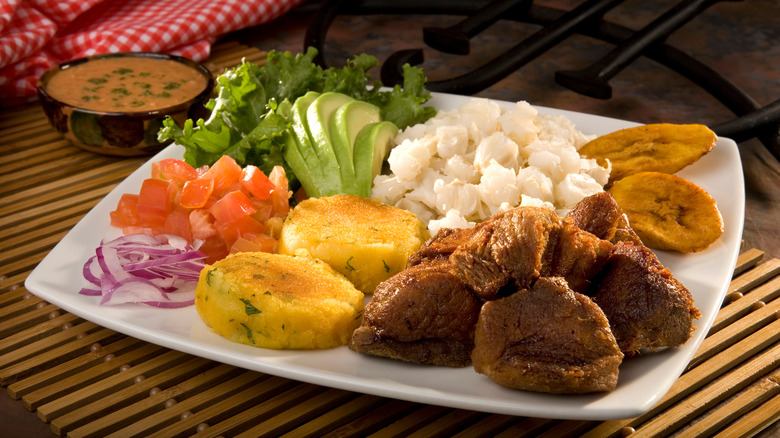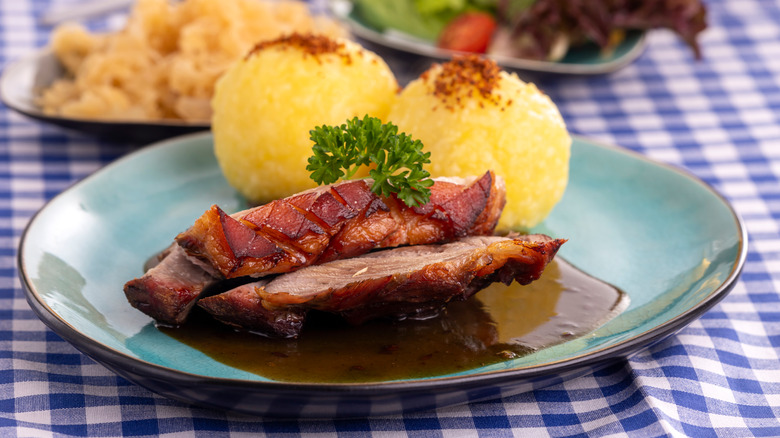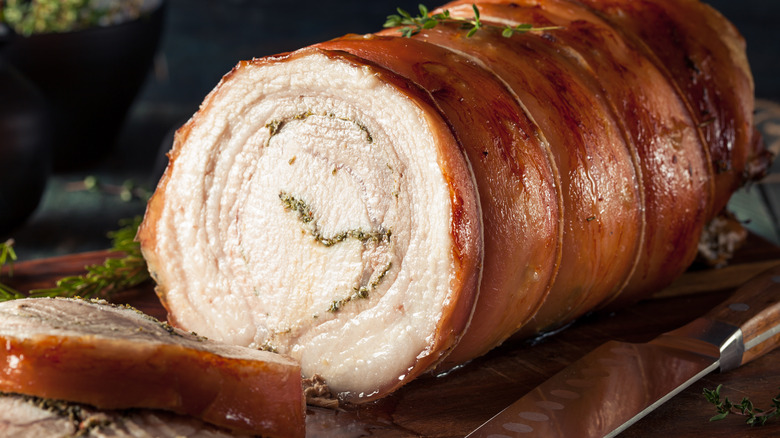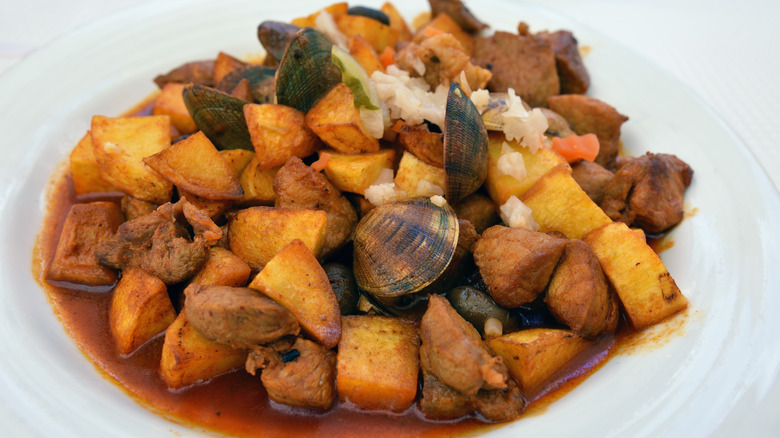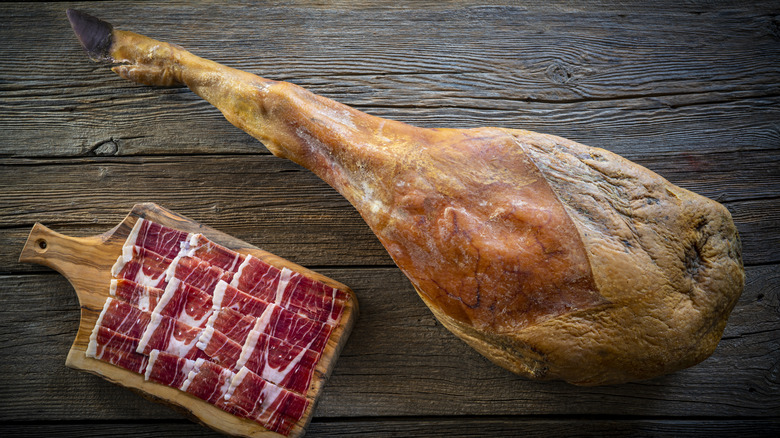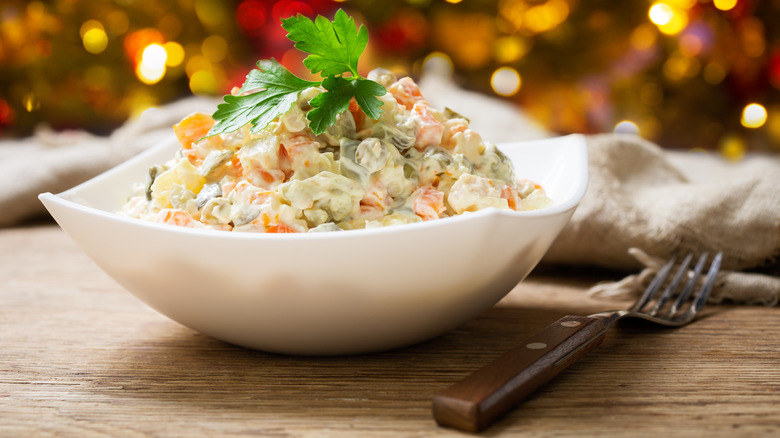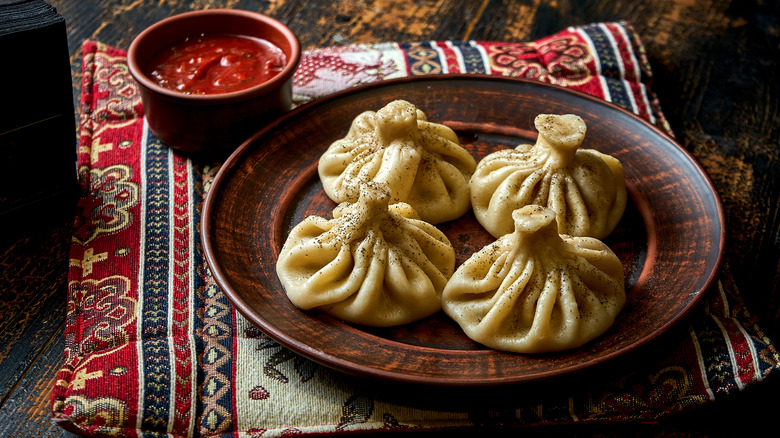30 Types Of Pork Dishes Around The World
All around the world, people are leading different lives, living in different countries, and pursuing different passions. Someone in New York is getting ready to sleep while someone in Perth is just waking up. We have our routines, and sometimes they take us to different places. But when we're missing home or nostalgic about our past, we all have that classic dish we crave. Every place in the world has its own traditional cuisine unique to them and the people who live there. Although we are different, food is something that unites us all.
Ingredients cross borders, but their preparation changes based on who is preparing them. An ingredient present across the globe and used in tons of traditional and oftentimes nostalgic dishes is pork. When it comes to pork, the prep possibilities have traversed both borders and generations. Here are some of the most popular pork dishes from around the world.
Tonkatsu (Japan)
Tonkatsu is the classic example of culinary fusion, having been created at a Western-style restaurant in 19th century Japan; the dish takes influence from French-style breaded veal cutlets but incorporates panko breadcrumbs for a less greasy and exceptionally crispy finish. Commonly made with pork loin, this Western-style Japanese cuisine is a popular comfort food that is easy to make and incredibly versatile. These pork cutlets are typically accompanied by a savory punchy tonkatsu sauce and can even be served on bread for the perfect katsu sando for any occasion.
Lechón (Philippines)
One of the most popular dishes in the Philippines, lechón is a spit-roasted pig that turns over hot charcoal for hours, resulting in crispy smoked skin and juicy, tender meat. It is one of the most succulent, flavorful ways to prepare pork. To prepare lechón, the pig is roasted for several hours and then skewered with a large metal spike to ensure even cooking throughout. Each region has its own variations. Some areas, like Cebu, opt to stuff the pig with aromatics such as lemongrass. Others opt for a simple seasoning of salt and pepper.
Pork xiaolongbao (China)
Xiaolongbao, or soup dumplings, are a Shanghai classic dating back to the 19th century. These dumplings are usually made with a minced pork filling, and once cooked, have a soupy interior.
The xiaolongbao broth is kept in the dumpling without leaking because the broth is gelatinous when cold. The gelatinous broth gets folded into the pork mixture and wrapped in a thin dough. The dumplings are steamed in a traditional bamboo steamer. Once steamed, the solidified broth melts, and a juicy, pork-filled bite awaits.
Pork bánh mì (Vietnam)
A staple dish that originates from French colonial rule of Vietnam, this sandwich can be found street-side or in restaurants all over the country. Commonly filled with pork, cilantro, and pickled vegetables, all served on a French baguette, it is a true example of culinary fusion. The sandwich is versatile, with options for chicken bánh mì or even tofu bánh mì, but the tried and true version will always be the OG pork bánh mì.
Char siu (China)
Char siu is a roasted, barbecued pork dish that has been enjoyed for thousands of years. It can be eaten as an affordable street food or an elevated fine-dining menu item. Char siu has a distinct red exterior coating that comes from fermented red bean curd present in the marinade. Some recipes opt for red yeast rice powder or even red food coloring to achieve that signature hue.
The marinade tends to include honey or sugar, which creates a sweet, sticky coating on the pork. Hoisin sauce, soy sauce, and Chinese five-spice seasoning are also commonly featured marinade ingredients, which help to balance out that sweetness.
Lu rou fan (Taiwan)
Lu Rou Fan is a classic Taiwanese comfort food that consists of braised pork belly served over rice with the braising sauce. There are regional variations, with some opting for a slab of pork belly and others for diced or minced pork. After a long braise in a thick sauce, the pork becomes melt-in-your-mouth tender and is the perfect bite after a long day. Simple but effective, lu rou fan will satisfy any pork fan.
Larb (Thailand)
Larb is a flavorful minced meat dish popular in many nations, including Thailand, Laos, and Myanmar. Historically, larb was served on important occasions or for honored guests because meat was less prevalent in people's diets. Nowadays, it is an affordable and flavorful dish with tons of potential variations, from spicy to sour and everything in between.
A classic Thai pork larb would include pork mince and seasonings like fish sauce, lemongrass, and fresh herbs. Some recipes include toasted rice powder. It is an incredibly flavorful, well-seasoned dish that is a must-try.
Pork satay (Thailand)
Satay is a form of skewered meat that is barbecued and accompanied by dipping sauce. Satay originated on the island of Java in Indonesia but has spread to many different countries and regions who have developed their own variations of the dish.
In Thailand, pork satay is a popular version. A typical satay features marinated meat grilled on bamboo skewers. Although the type of skewered meat varies amongst satays, the peanut sauce that accompanies it is a quintessential pairing.
Gua bao (Taiwan)
Gua Bao, nicknamed "Taiwan's Hamburger," is a Taiwanese street food that has gained global popularity in recent years. Made with flavorful braised pork belly and pickled vegetables wrapped between a soft plushy steamed bao bun, there's no wonder it's taking the world by storm.
Go to any street corner in Taipei, and you'll find this traditional Hokkien dish. Gua Bao is traditionally served with pork, cilantro, pickled vegetables, and peanut powder. The sticky, soft pork is perfectly cut by the acidity of the pickle veggies, making for a balanced, delicious snack that you'll crave for days after eating.
Nem lụi huế (Vietnam)
Nem Lụi Huế is a popular Vietnamese street food. These pork skewers are typically made by wrapping seasoned ground pork around sticks of lemongrass and roasting them. The lemongrass acts as a natural skewer, imparting its bright flavor into the meat as it roasts.
The dish, originating in the region Huế, is made with pork ground into a paste and commonly mixed with fish sauce, garlic, shallot, and black pepper. These pork skewers are both affordable and filling and can be enjoyed either as a snack or a full-course meal.
Feijoada (Brazil)
If you want the taste of Brazil, look no further. Feijoada, the national dish of Brazil, is a hearty stew filled with black beans and different cuts of pork. This dish takes hours to make, but it is definitely worth it.
The stew incorporates a variety of pork cuts, like smoked pork, pork belly, and pork sausage. Every Brazilian family has their own version, and it is the ultimate comfort food. With feijoada, the sides are a crucial part of the dish, as they help to ease the heaviness of the stew itself. Feijoada is typically served with orange slices, rice, sautéed greens, and farofa, otherwise known as toasted cassava flour.
BBQ pulled pork (USA)
The southern classic we all know and love, BBQ pulled pork, is traditionally made with pork shoulder that has been slowly smoked until it is pull-apart tender. Once the shoulder is shredded, it is tossed in a tangy BBQ sauce and is often served on a bun or toast.
Barbecuing for pulled pork used to involve spit-roasting a full pig. Now, there are a variety of methods used in making pulled pork that are more accessible to the everyday cook. An easy pulled pork recipe typically uses a slow cooker to ensure low and slow-cooked meat without the extra work.
Spam musubi (Hawaii)
This affordable Hawaiian snack uses Spam, a processed canned pork brand. The Spam is sliced, and each slice is marinated and fried. The slices are then set over rice and wrapped in a Japanese seaweed called nori.
For Spam musubi, the marinade provides a sticky umami experience that pairs well with the salty pork. At its most basic, a simple Spam musubi marinade combines sugar, soy sauce, and mirin. It is a cheap, flavorful, and filling snack that can be found in gas stations or food stands across the islands.
Carnitas (Mexico)
Essentially, the Mexican version of pulled pork carnitas is a slow-cooked succulent pork dish that is incredibly versatile. It is often served in tortillas or over rice. Fried in its own fat, some chefs like to add aromatic flavor additions like orange juice or cola to season the meat as the carnitas cooks.
Served simply with diced onion and cilantro or put into a burrito, it is truly a Mexican staple. To make carnitas at home, using a slow cooker is a great option. Slow cooker carnitas will fulfill all pork cravings and make for an easy cleanup.
Pernil (Puerto Rico)
One of Puerto Rico's most well-known dishes, pernil is a tender marinated pork dish made with pork shoulder. It is commonly served on special occasions and tends to be served with rice and beans.
Also known as "lechón asado," this roast pork dish originally began from roasting a full pig over a flame. Nowadays, people opt for just the shoulder or loin when making pernil. The pork is marinated in an acidic, herby mixture with garlic and oregano, resulting in a super flavorful, tender meal.
Cubano (USA)
The Cubano is a classic sandwich whose origin story isn't fully proven. Researchers believe it was created in Cuba but popularized in Florida after an influx of Cuban immigrants arrived in the 1950s.
The sandwich, made with ham, roasted pork, pickles, mustard, and Swiss cheese, has become a Florida staple. The sandwich is served on Cuban bread that is pressed, giving a crunchy exterior texture and a juicy, melted middle. Both Tampa and Miami claim to have the best Cuban sandwich, but if you're not in these cities, you can still make a Cuban sandwich at home.
Al pastor (Mexico)
The origins of al pastor are from Lebanon, where lamb is often roasted on a spit and served in slices. Lebanese immigrants took their techniques in making this lamb shawarma and introduced it to Mexico, where it served as an influence for al pastor.
Al pastor, or "shepherd-style," is a flavorful style of prepping Mexican street food, often pork. Sliced pork, typically shoulder, is marinated with chilies and spices and cooked on a rotating spit. The rotating spit gives a nice crunchy char to the outside of the meat and a tender, juicy finish to the meat inside.
Sausage gravy (USA)
Everyone knows biscuits and gravy is a classic Southern breakfast staple. Sausage gravy is a creamy, wholesome sauce with humble beginnings. The recipe was established during the American Revolutionary War because it's made from some of the few ingredients that were available at the time.
It has stood the test of time and remains a popular breakfast dish that always hits the spot. The gravy is savory and saucy and is often poured over flaky biscuits. A simple sausage gravy can be made with pork sausage, pan drippings, flour and milk, making it an accessible, filling meal.
Pozole (Mexico)
Pozole is a hearty stew with origins that predate the nation of Mexico itself. A popular dish in Mesoamerica, which included slow-cooked meat and corn, it has evolved over time into an incredibly tasty, warming dish made with pork and hominy. Now, there are a variety of different preparations to enjoy.
Three types of pozole that are popular are pozole verde (green pozole), pozole rojo (red pozole), and pozole blanco (white pozole). These broths are colored green, red, and white to symbolize the Mexican flag.
Fritada (Ecuador)
Fritada, not to be confused with frittata, is a common Ecuadorian dish with braised pork as the star. Originating in the Andean highlands in the colonial era, the fritada is a flavorful, smoky dish that can be found in many restaurants and eateries.
Diced pork is often cooked in water or orange juice over high heat until the liquid evaporates and then fried in its own fat. It can be cooked with garlic and onions and is served with sides like potatoes, plantains, corn, or fava beans, depending on the region.
Kielbasa (Poland)
Spread by Polish immigrants all over the world, kielbasa is enjoyed by everyone who has a taste for a classic smoked sausage. Kielbasa is the broad term for Polish sausage with specific varieties, each having their own designations. Kabanosy is a thin variation made of pork and flavored with caraway seeds, while kielbasa myśliwska, translated to English as 'hunter's sausage,' uses juniper as its main flavor. Whether you are going on a picnic, having a snack, or dining out, kielbasa will fulfill all of your sausage cravings.
Schweinebraten (Germany)
Schweinebraten is a classic pork roast that originated in Bavaria and was popular among royalty and the wealthy during the Middle Ages, as pork products were largely inaccessible to commoners. Nowadays, German pork dishes are not only accessible but celebrated, especially during Oktoberfest.
Schweinebraten is a classic Oktoberfest meal and is very popular amongst Germans. Each region has its own variations, but at its core, the dish is made with boneless pork shoulder, roasted until tender, and served with gravy and dumplings.
Porchetta (Italy)
Crispy on the outside and nice and moist on the inside, this classic oven-roasted pork dish is recognized by the Italian government as a representative regional dish. Its popularity spread to France and North America, each having its own variation on the Italian classic. The stuffing in porchetta can consist of garlic, fennel, and parsley and often varies based on the local recipes and flavors. Regardless of which way you go with your stuffing, porchetta will never fail to please.
Pork pie (United Kingdom)
A pastry-wrapped bundle of pork goodness, the British pork pie is a classic that has been around for centuries. The crust itself is sturdy and laced with lard. There have been historic variations regarding the pork filling itself, but nowadays, one should expect minced pork shoulder, belly, or both.
Since the minced meat tends to shrivel upon cooking, jelly is poured through a hole atop the pie in order to maintain that moist texture. Pork pies are a British staple and can be found all over the U.K. at farm stands, grocery stores, and butchers.
Pork schnitzel (Germany/Austria)
Everyone loves a fried, breaded cutlet and the pork schnitzel is one of the best variations there is. Made with boneless pork chops and pound until thin, the chops are then breaded and fried in oil or butter to create a crispy cutlet perfect for any occasion.
Pork schnitzel is a common substitute for the classic wiener schnitzel, which is made with veal. It can be served with lemon slices, potato salad, and cranberry sauce. Pork schnitzel and braised cabbage is another tasty pairing. This dish is a common choice as a day-to-day meal for the family.
Carne de Porco à Alentejana (Portugal)
Carne de Porco à Alentejana is a popular, traditional dish in Portugal that includes pork, clams, and potatoes. It's the perfect surf and turf dish that will make you feel transported to the coasts of Portugal. Marinated pork and clams are served in a semi-spicy white wine sauce and topped with cilantro, potatoes, and lemon slices. The vibrant dish is packed with flavor and can be found in restaurants and seaside spots all over the country.
Jamón Ibérico (Spain)
One of the more expensive cuts of pork, Jamón Ibérico, or Iberian ham, is a type of cured pork originating in the Iberian peninsula. It can only be sourced from black Iberian pigs or a variation including the black Iberian ancestry. The pigs have a specialized diet of certain grains and nuts like acorns and chestnuts.
Dry-cured to perfection and served straight from the leg or presented in slices, this is a must-try cut of meat with a delicate, nutty flavor. This Spanish delicacy is notable for the fatty marbling present in each slice.
Olivier salad (Russia)
This traditional salad from the Russian Empire uses diced ham, pickles, and vegetables all tossed together in mayonnaise for a hearty filling dish. It is a staple appetizer for New Year's celebrations in Russia and post-Soviet countries.
Also known as Russian potato salad, this celebratory dish was created in Moscow in the 1860s by a Belgian chef named Lucien Olivier. The original used gourmet ingredients like caviar and crayfish, but has since evolved into a dish that is much more affordable. Although the individual ingredients seem simple, when combined, an addicting, perfectly textured salad is born.
Scotch egg (United Kingdom)
When it comes to the origins of the Scotch egg, there is a lot of debate. No matter where the Scotch egg came from, one thing is certain: it's delicious.
A comforting snack served in pubs and bars across the nation, the Scotch egg is a classic dish. Savory pork sausage encases a boiled egg and is breaded and fried or baked to perfection. The scotch egg may seem unassuming at first, but once cut in half, it reveals juicy, seasoned pork with a perfect full egg at its core.
Khinkali (Georgia)
Most cultures have some variation of dumplings in their culinary repertoire. For Georgia, it's khinkali. Khinkali is a large meat-filled dumpling that can be found all over the country. There are a few variations of khinkali, but a common one contains a filling mixture of pork and beef along with stock. Rather than being steamed, like xiaolongbao, khinkali is boiled. The soupy interior stays intact in the process, and when served, a simple crack of black pepper is all that's needed.
